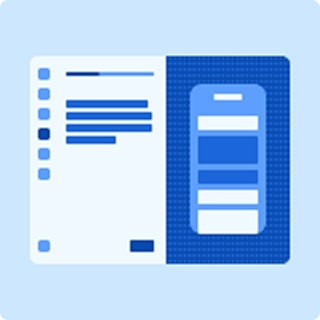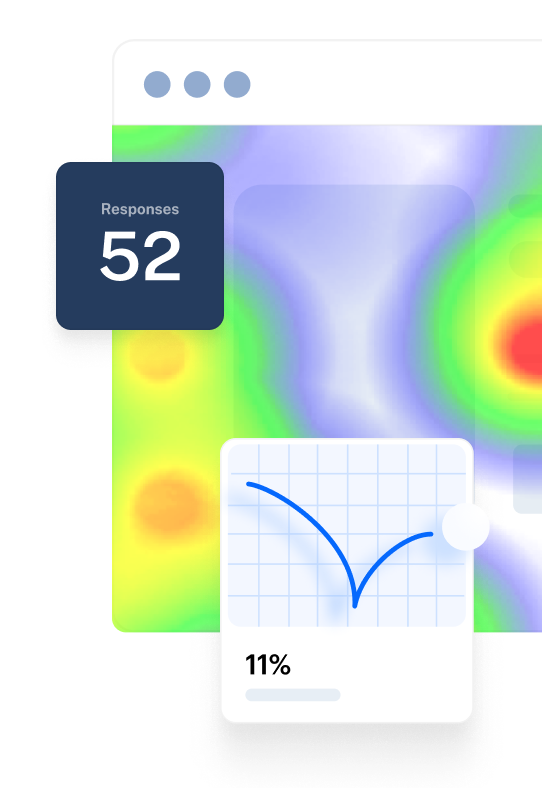Chapter 10
What is guerrilla usability testing?
In this chapter, you'll learn everything you need to know to run guerrilla usability testing, including finding participants, setting up tasks, and more.
If you’re a user experience designer or researcher—or you’ve read the other chapters of this guide—you already understand the value of investing time and money into usability testing. But the common limitations of many design projects may still force you to ask this question:
What if I really don’t have much time for usability testing?
The answer is to take a DIY approach that’s quick and affordable enough to meet the constraints of any deadline: guerrilla usability testing. Not only does it have an exciting-sounding name, but it’s also an effective way to identify usability issues and get valuable insights from people fast.
And while it may not be as rigorous as your normal type of testing, guerrilla testing is far, far more preferable to the alternative—not testing at all.
So let’s take a look at the guerrilla option: what it is, when you should do it, and how to make your guerrilla test a success.
Should you perform guerrilla usability testing?
Guerrilla usability testing aims to cut out the time-consuming parts of the user testing process. A designer, researcher, or anyone building a product takes to the streets and finds members of the public to participate in a quickfire, on-the-spot guerrilla usability test.
The term ‘guerrilla’ was first used to describe small groups of armed forces that would launch quick, unexpected strikes on specific targets to make up for their lack of numbers and resources. Since then, it’s become a word to describe any activity performed in an impromptu, unconventional, and effective way.
So if the typical assumptions around usability testing are:
- Finding willing test participants can take time
- Arranging testing sessions in an office or usability lab is difficult to organize
- Compensating participants for their time requires a slice of the budget
Guerrilla usability testing challenges these assumptions by:
- Directly asking members of the public to participate in usability tests
- Doing the test right then and there
- Giving people a small token of gratitude for sparing a few minutes of their time
If it sounds simple, that’s because it is. But that doesn’t mean that guerrilla research is too scrappy to provide actionable user feedback. It can actually work just as well as traditional user research methods. Here’s why.
Is guerrilla testing actually useful?
Guerrilla testing works for the simple reason that you're testing with people who haven't seen your design yet. Within your office, these people are probably in short supply. But outside, they’re everywhere—and going directly to them is a massive shortcut compared to arranging for them to come to you. It's a good way to get some quick feedback without investing a lot of resources into traditional user testing.
Guerrilla usability testing can give you the completely blank slate perspective: someone who has never heard of your software, doesn’t work in your target audience, isn't from your target demographic, and doesn’t meet your expected level of competency. Those results can be very enlightening, but need to be balanced with thoughtful research goals and outcomes.

Taylor Palmer
Product Design Lead at Range
If your budget or deadline doesn’t allow for traditional usability testing, some guerrilla testing early in the design process can help validate your initial ideas.
And even if you do have the time and money to recruit users for pre-arranged or remote testing, you might want to consider complementing your user research with quick guerrilla tests when you need a quick way to test your solutions with real users.
The ideal time for guerrilla testing
Guerrilla testing works best as a type of formative testing. This means it’s particularly useful when you need to validate assumptions and identify core usability problems at an early stage of the design process. For instance, if you need some quick data to test the early direction of your design and user interface—but don’t want to go for an established usability testing process, that’s where guerrilla usability testing comes in.
David Simon from UXBooth explains how he used guerrilla usability testing to build a website on a tight deadline:
Once a week throughout the project, we tested different kinds of prototypes to bring the business’s ideas to life. This revealed navigational problems, and even ended up shaping a bit of the brand’s media material.
David Simon
UXBooth
He also reveals a positive side effect of guerrilla testing early: “Guerrilla usability testing opened our stakeholders’ eyes so that they challenged their own, innate assumptions about the user.”
Designers will be all too familiar with the challenges of getting buy-in from stakeholders to invest time and money into user testing. So if you can get eye-opening results at the prototyping stage with minimal resources, you can prove the value of sharing your product with users without investing too much time and resources into traditional user testing.
However, once you get to the stage where you need more finely-tuned feedback on the overall usability of your designs, it’s better to test a higher number of people in a more standardized way. At this point, it’s best to swap the guerrilla testing for summative testing methods.
How to do guerrilla usability testing
By now, we have seen that guerrilla usability testing is an excellent way to test your solutions with real users quickly. But how exactly do you perform a guerrilla test?
Here are some steps and recommendations you can follow to run a successful guerrilla test, including planning your testing sessions, finding the right participants and place, and more.
Plan the test
Although guerrilla usability testing requires fewer resources than traditional user testing, that doesn’t mean less planning. Before approaching the participants, get ready by writing a script for your testing session. Think about what you should test, the scope of your research, and the tasks you want the participants to complete.
To start, prepare a realistic prototype to test with users. The fidelity of your guerrilla testing prototype will depend on where you’re up to in the design process. If you plan on testing very early—which is generally a good idea—some designers say that a paper prototype or drawings will do.
However, UX designer Nick Babich disagrees:
Many researchers print out designs and ask the participant to test paper sheets. This isn’t the right way to do guerrilla testing because that’s not how someone experiences a product in real life. You can’t expect people to understand how your product works by flipping through paper pages.
Nick Babich
Editor-in-chief of UX Planet
Instead, he advocates at least using some kind of working prototype:
The more the prototype resembles a real product, the more valuable feedback you’ll receive.
Nick Babich
Editor-in-chief of UX Planet
Once you have your prototype, it’s time to map out the specific tasks that the users will be carrying out. The standard tips on writing usability tasks apply: keep your list of tasks short and simple, avoid leading questions, and use as few steps as possible. Simplicity is especially important for guerrilla testing, as participants will lack some of the context around your product that they’d have in a conventional, pre-arranged test.
So make sure your research objectives don't require any prior feature-specific knowledge of your product. You could even try it out on a friend or family member to be safe. For the full guerrilla test rehearsal, ask them out of the blue over breakfast.
Finally, limit the scope of your test, so it specifically focuses on one core user objective. You don’t want to take up too much of people’s time—10-15 minutes tops—and the more precise your testing hypothesis, the easier it is to compare results between tests and spot trends.
Find the right participants and place
Since the main differentiator of guerrilla testing is finding test subjects in public places, getting this part right is key. The one potential disadvantage of the guerrilla approach is that the people you test might not represent your target demographic, which makes your results less reliable.
Here’s a few tips on finding the right kind of participants:
- Go to a relaxed location: people who are in a rush to get somewhere don’t make good test-takers. Head somewhere where people will have a few minutes to spare. Coffee shops are a popular choice for guerrilla tests.
- Think like your audience: ask yourself where your target audience would spend time. If you’re testing a fitness mobile app, catch people on their way out of the gym. For a travel app, an airport café would be an ideal spot.
- Get some background info: before you start the test, ask people a few questions to see if they’re the type of person who’d use your product (e.g. How often do you shop online? Do you use any similar apps?).
- Take your search online: guerrilla testing online can work just as well. Hang out in forums or subreddits where your audience is, then share a link to your usability test with a platform like Maze.
It’s important that your guerrilla test participants resemble your target audience, so keeping these tips in mind will narrow your search.
Run a successful guerrilla usability test
Once you’ve found a participant who seems to fit your target profile, the test itself should unfold just like a normal usability test. Get people to share their thoughts and opinions with the think-aloud protocol, leave open-ended questions until the end, and make a note of common trends in user behavior.
There are just a few extra things to be aware of when honing your in-field testing technique:
- Stay connected: wherever you decide to look for participants, make sure you have a strong internet connection. You don’t want to be battling bad Wi-Fi mid-test.
- Provide extra context: when you first approach someone, give a precise explanation of both the test scenario and user testing in general. They’ve probably never heard of user testing, so it’s important to make sure they understand that the product is being tested—not them.
- Offer something in return: obviously you can’t give everyone a free iPhone—if you had that kind of budget, you wouldn’t be guerrilla testing in the first place. But you should still give away something small for people’s time. Even a chocolate croissant or a voucher can go a long way.
- Bring a partner along: between writing notes, keeping people engaged, and making sure your laptop is properly set-up, guerrilla testing alone can feel like spinning plates. So get a colleague to come with you and split the tasks. One extra person is enough—more people can make participants feel daunted.
Short on time and money? Go guerrilla.
The most common reasons that designers give for skipping user testing are time and money. But paradoxically, these are also two of the most important reasons you should test—no matter what. As designer Jonathan Weber says:
At its core, user testing can help save money and time, as well as increasing user satisfaction for your business or product.
Jonathan Weber
designer
So if remote usability testing is not an option, guerrilla testing is still a massive improvement on no testing at all. And besides that, it’s a chance to get out of the office and talk to potential users—which is both important, and fun.
Frequently asked questions about guerrilla usability testing
How do you conduct a guerrilla test?
How do you conduct a guerrilla test?
Guerrilla usability testing involves finding test subjects in public spaces and asking them to participate in the research. So a first vital step for conducting a successful test is to find the right participants that that represent your target audience.
When running the guerrilla test, make sure you have a strong internet connection and provide participants extra context around the test and your product. Limit the scope of your test and keep your list of tasks short and simple—ideally, sessions should last no more than 15 minutes. When the test is over, offer participants a small gift as a thank you for their time.
What are some methods used for usability testing?
What are some methods used for usability testing?
There are various usability testing methods available, depending on your goals and needs. For example, you can choose between quantitative and qualitative data or between moderated and unmoderated usability testing. Other methods you can use include guerrilla testing, lab usability testing, contextual inquiry, phone interview, and session recordings. With the advancement of technological innovation, remote usability testing has also increased in practice, becoming one of the most common routes to take.



